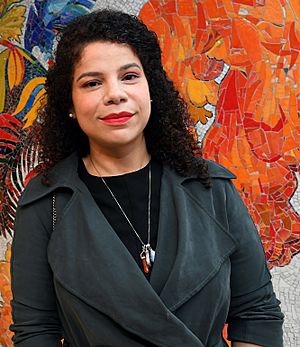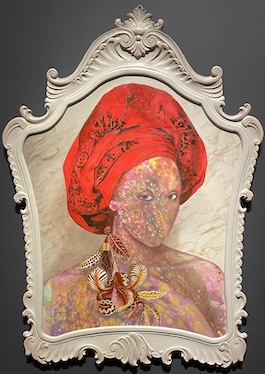Firelei Báez facts for kids
Quick facts for kids
Firelei Báez
|
|
|---|---|

Báez with her mosaic at 163 St-Amsterdam Av
|
|
| Born | 1981 (age 43–44) Santiago de los Caballeros, Dominican Republic
|
| Nationality | American |
| Education | Miami Jackson High School The Cooper Union Hunter College |
| Awards | Future Generation Art Prize (2017) |
Firelei Báez (born 1981) is an artist from the Dominican Republic. She now lives in New York City. Báez is famous for her detailed artworks on paper and canvas. She also creates large sculptures. Her art often tells stories that haven't been heard before. She uses pictures of people, landscapes, and designs to explore ideas about history and culture.
Her artwork has been shown in many important places. These include the New Museum in New York and the Pérez Art Museum Miami. Her art was also part of big shows like Prospect New Orleans and the 2018 Berlin Biennale. She won the Future Generation Art Prize in 2017. She also received the Joan Mitchell Foundation Painters and Sculptors Award in 2010.
Contents
Early Life and Education
Firelei Báez was born in 1981 in Santiago de Los Caballeros. This city is in the Dominican Republic. Her mother was Dominican, and her father was of Haitian descent. She grew up in Dajabón, a market town near the border with Haiti. When she was 8 years old, her family moved to Miami, Florida.
In 2001, Báez moved to New York. She studied art at Cooper Union and earned a bachelor's degree. Later, she got her master's degree in fine arts from Hunter College in 2010. She also studied at the Skowhegan School of Painting and Sculpture.
Her Art and Career
Firelei Báez is an artist who lives and works in New York City. She is known for her detailed paintings and drawings. She also creates big sculptures and art installations. Around 2012, she started painting with ink and acrylic on special paper called Yupo. This paper doesn't soak up paint, which helps her create unique effects. Later, she began painting directly onto old maps and building plans.
Her art often looks at Western culture from a different point of view. She uses images from popular culture to show bodies in ways that question ideas about race and social class. Báez says that artist David Hammons inspired her. He showed her how art could represent Black and Brown people's lives. She also gets ideas from the science fiction writer Octavia E. Butler. Butler's ideas about Afrofuturism often appear in Báez's work. For example, one of Báez's paintings shows a scene from Butler's book, Parable of the Sower (novel).
In 2015, Báez had two solo art shows. These were Patterns of Resistance and Bloodlines. In 2016, she created an interactive art piece at the Metropolitan Museum of Art. Visitors could take part in making the art.
Public Artworks
In 2018, Firelei Báez created a large public artwork. It was for the Metropolitan Transportation Authority in New York. She made two glass-tile murals for the 163 St-Amsterdam Avenue subway station. The artwork is called The Brief Wonderous Life of Oscar Wao. This name comes from a book by Junot Díaz.
The murals show detailed patterns of tropical plants and vines. These designs connect to Báez's Caribbean background. They also reflect the people living in the neighborhood. The art also includes images of "hand symbols" and female figures. These figures are like Ciguapas from Dominican folklore. Báez wanted the artwork to feel familiar and special to Dominicans in the area. A company called Mayer of Munich helped create the glass mosaics from her designs.
Exhibitions and Shows

Firelei Báez has had many solo art shows. Some of these include:
- Psycho*Pomp (2012) at the University of Nevada, Reno.
- Firelei Báez: Bloodlines (2015) at the Pérez Art Museum Miami.
- Firelei Báez: Joy Out of Fire (2018) at the Schomburg Center for Research in Black Culture and Brooklyn Museum.
- The Modern Window: For Améthyste and Athénaire (2018-2019) at the Museum of Modern Art.
- Firelei Báez (2021) at the ICA Watershed.
She has also been part of many group exhibitions. These include the El Museo del Barrio Biennial (2011-2012) and the Berlin Biennale (2018).
In 2021, Báez created a large art installation. It was called To breathe full and free. This artwork was shown at the Watershed exhibit space of the Institute of Contemporary Art, Boston. It was inspired by the old ruins of the Sans-Souci Palace in Haiti. This grand palace was built by Henri Christophe, a Haitian revolutionary, in 1813.
In 2023 and 2024, Báez's work was featured in a traveling group show called Spirit in the Land. This show explored how human bodies connect with nature. In 2024, the Institute of Contemporary Art, Boston held the first big show looking back at her entire career.
Can I Pass? Series
From 2011 to 2013, Báez created a series of self-portraits. She painted a silhouette of her face and hair every day. Each painting was made in a color that matched her forearm. This color was similar to a paper bag. She used this color to remind people of the historical Brown paper bag test. This test was a unfair way to judge Black people in the United States. She also focused on hairstyles in these portraits. This connects to a "fan test" used in the Dominican Republic. This test linked hair that didn't blow straight back to African heritage.
Art Symbols and Themes
In her art, Firelei Báez often uses symbols and figures from Dominican stories and history. These symbols highlight different ideas about women, race, power, and nature. One important figure she uses is the Ciguapa. This is a mythical creature from Dominican folklore. Báez painted ciguapas in many works from 2005 to 2015. She first painted them on old library books. Later, she painted them on very large canvases.
She also includes Anacaona in her art. Anacaona was an important historical figure from Hispaniola. Báez included her in a map painting called Untitled (Anacaona). This artwork shows how the body can be a symbol of strength and freedom.
Awards and Fellowships
Firelei Báez has received many awards and special fellowships for her art. Some of these include:
- Joan Mitchell Foundation Painters and Sculptors Award (2010)
- Catherine Doctorow Prize for Contemporary Painting (2015)
- Chiaro Award from the Headlands (2016)
- Future Generation Art Prize (2017)
- College Art Association Artist Award for Distinguished Body of Work (2018)
- Smithsonian Artist Research Fellowship (2019)
- Soros Art Fellowship (2019)
- The Herb Alpert Awards in the Arts (2020)
- American Academy in Rome Philip Guston Rome Prize for visual arts (2021)
Notable Artworks in Public Collections
Many museums and art collections own Firelei Báez's work. Some of her notable pieces include:
- Amidst the future and present there is a memory table (2013) at the Ruth and Elmer Wellin Museum of Art.
- To see beyond it and to access the places that we know outside its walls (2015) at the San Jose Museum of Art.
- Sans-Souci (This threshold between a dematerialized and a historicized body) (2015) at the Pérez Art Museum Miami.
- Of Love Possessed (lessons on alterity for G.D. and F.G at a local BSS) (2016) at the Spelman College Museum of Fine Art.
- To Access the Places that Lie Beyond (2017) at the Kemper Museum of Contemporary Art.
- Elegant gathering in a secluded garden (or the many bridges we crossed) (2018) at the Studio Museum in Harlem.
- An Open Horizon (or the stillness of a wound) (2019) at the Cornell Fine Arts Museum.
- Tignon for Ayda Weddo (or that which a center can not hold) (2019) at the Nasher Museum of Art.
- the trace, whether we are attending to it or not (a space for each other's breathing) (2019) at the New Orleans Museum of Art.
- Untitled (Central Power Station) (2019) at the Dallas Museum of Art.
- Untitled (Tabula Anemographica seu Pyxis Navtic) (2021) at the Whitney Museum of American Art.
- Olamina (How do we learn to love each other while we are embattled) (2022) at the Metropolitan Museum of Art.
See also
- List of American artists 1900 and after


